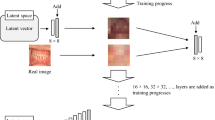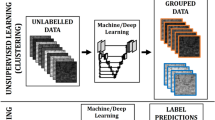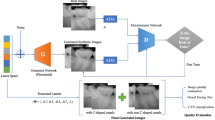Abstract
Objectives
This systematic review on generative adversarial network (GAN) architectures for dental image analysis provides a comprehensive overview to readers regarding current GAN trends in dental imagery and potential future applications.
Methods
Electronic databases (PubMed/MEDLINE, Scopus, Embase, and Cochrane Library) were searched to identify studies involving GANs for dental image analysis. Eighteen full-text articles describing the applications of GANs in dental imagery were reviewed. Risk of bias and applicability concerns were assessed using the QUADAS-2 tool.
Results
GANs were used for various imaging modalities, including two-dimensional and three-dimensional images. In dental imaging, GANs were utilized for tasks such as artifact reduction, denoising, and super-resolution, domain transfer, image generation for augmentation, outcome prediction, and identification. The generated images were incorporated into tasks such as landmark detection, object detection and classification. Because of heterogeneity among the studies, a meta-analysis could not be conducted. Most studies (72%) had a low risk of bias in all four domains. However, only three (17%) studies had a low risk of applicability concerns.
Conclusions
This extensive analysis of GANs in dental imaging highlighted their broad application potential within the dental field. Future studies should address limitations related to the stability, repeatability, and overall interpretability of GAN architectures. By overcoming these challenges, the applicability of GANs in dentistry can be enhanced, ultimately benefiting the dental field in its use of GANs and artificial intelligence.






Similar content being viewed by others
Data availability
The data that support the findings of this study are available from the corresponding author upon reasonable request.
References
Yi X, Walia E, Babyn P. Generative adversarial network in medical imaging: a review. Med Image Anal. 2019;58:101552.
Goodfellow I, Pouget-Abadie J, Mirza M, Xu B, Warde-Farley D, Ozair S, et al. Generative adversarial networks. Commun ACM. 2020;63:139–44.
Deng J, Dong W, Socher R, Li L-J, Li K, Fei-Fei L. Imagenet: a large-scale hierarchical image database. In: Proceedings of the 2009 IEEE conference on computer vision and pattern recognition. IEEE; 2009.
Irvin J, Rajpurkar P, Ko M, Yu Y, Ciurea-Ilcus S, Chute C, et al. Chexpert: a large chest radiograph dataset with uncertainty labels and expert comparison. In: Proceedings of the proceedings of the AAAI conference on artificial intelligence; 2019.
Johnson AE, Pollard TJ, Shen L, Lehman L-WH, Feng M, Ghassemi M, et al. MIMIC-III, a freely accessible critical care database. Sci Data. 2016;3:1–9.
Sorin V, Barash Y, Konen E, Klang E. Creating artificial images for radiology applications using generative adversarial networks (GANs)—a systematic review. Acad Radiol. 2020;27:1175–85.
Shamseer L, Moher D, Clarke M, Ghersi D, Liberati A, Petticrew M, et al. Preferred reporting items for systematic review and meta-analysis protocols (PRISMA-P) 2015: elaboration and explanation. BMJ. 2015;2015:349.
Schardt C, Adams MB, Owens T, Keitz S, Fontelo P. Utilization of the PICO framework to improve searching PubMed for clinical questions. BMC Med Inform Decis Mak. 2007;7:1–6.
Hegazy MAA, Cho MH, Lee SY. Half-scan artifact correction using generative adversarial network for dental CT. Comput Biol Med. 2021;132:104313.
Hu Z, Jiang C, Sun F, Zhang Q, Ge Y, Yang Y, et al. Artifact correction in low-dose dental CT imaging using Wasserstein generative adversarial networks. Med Phys. 2019;46:1686–96.
Jiang C, Zhang Q, Ge Y, Liang D, Yang Y, Liu X, et al. Wasserstein generative adversarial networks for motion artifact removal in dental CT imaging. In: Proceedings of the progress in biomedical optics and imaging—proceedings of SPIE; 2019.
Koike Y, Anetai Y, Takegawa H, Ohira S, Nakamura S, Tanigawa N. Deep learning-based metal artifact reduction using cycle-consistent adversarial network for intensity-modulated head and neck radiation therapy treatment planning. Physica Med. 2020;78:8–14.
Park HS, Jeon K, Lee SH, Seo JK. Unpaired-paired learning for shading correction in cone-beam computed tomography. IEEE Access. 2022;10:26140–8.
Khaleghi G, Hosntalab M, Sadeghi M, Reiazi R, Mahdavi SR. Metal artifact reduction in computed tomography images based on developed generative adversarial neural network. Inf Med Unlock. 2021;24:100573.
Hegazy MAA, Cho MH, Lee SY. Image denoising by transfer learning of generative adversarial network for dental CT. Biomed Phys Eng Express. 2020;6:055024.
Moran MBH, Faria MDB, Giraldi GA, Bastos LF, Conci A. Using super-resolution generative adversarial network models and transfer learning to obtain high resolution digital periapical radiographs. Comput Biol Med. 2021;129:104139.
Huang Y, Fan F, Syben C, Roser P, Mill L, Maier A. Cephalogram synthesis and landmark detection in dental cone-beam CT systems. Med Image Anal. 2021;70:102028.
Lee C, Ha EG, Choi YJ, Jeon KJ, Han SS. Synthesis of T2-weighted images from proton density images using a generative adversarial network in a temporomandibular joint magnetic resonance imaging protocol. Imaging Sci Dent. 2022;52:393–8.
Kim M, Kim S, Kim M, Bae HJ, Park JW, Kim N. Realistic high-resolution lateral cephalometric radiography generated by progressive growing generative adversarial network and quality evaluations. Sci Rep. 2021;11:12563.
Kokomoto K, Okawa R, Nakano K, Nozaki K. Intraoral image generation by progressive growing of generative adversarial network and evaluation of generated image quality by dentists. Sci Rep. 2021;11:18517.
Krishnamoorthy VK, Baskaran S. Optimized adversarial network with faster residual deep learning for osteoarthritis classification in panoramic radiography. Int J Intell Eng Syst. 2022;15:191–200.
Kearney VP, Yansane A-IM, Brandon RG, Vaderhobli R, Lin G-H, Hekmatian H, et al. A generative adversarial inpainting network to enhance prediction of periodontal clinical attachment level. J Dent. 2022;123:104211.
Park YS, Choi JH, Kim Y, Choi SH, Lee JH, Kim KH, et al. Deep learning-based prediction of the 3D postorthodontic facial changes. J Dent Res. 2022;101:1372–9.
Yong TH, Yang S, Lee SJ, Park C, Kim JE, Huh KH, et al. QCBCT-NET for direct measurement of bone mineral density from quantitative cone-beam CT: a human skull phantom study. Sci Rep. 2021;11:15083.
Li Y, Wang J, Liang W, Xue H, He Z, Lv J, et al. CR-GAN: automatic craniofacial reconstruction for personal identification. Pattern Recogn. 2022;124:108400.
Jeong JJ, Tariq A, Adejumo T, Trivedi H, Gichoya JW, Banerjee I. Systematic review of generative adversarial networks (GANs) for medical image classification and segmentation. J Digit Imaging. 2022;35:137–52.
Radford A, Metz L, Chintala S. Unsupervised representation learning with deep convolutional generative adversarial networks. Preprint arXiv:1511.06434; 2015.
Mao X, Li Q, Xie H, Lau RY, Wang Z, Paul Smolley S. Least squares generative adversarial networks. In: Proceedings of the IEEE international conference on computer vision; 2017.
Weng L. From GAN to WGAN. arXiv Preprint arXiv:1904.08994; 2019.
Karras T, Aila T, Laine S, Lehtinen J. Progressive growing of GANS for improved quality, stability, and variation. arXiv Preprint arXiv:1710.10196; 2017.
Karras T, Laine S, Aittala M, Hellsten J, Lehtinen J, Aila T. Analyzing and improving the image quality of stylegan. In: Proceedings of the IEEE/CVF conference on computer vision and pattern recognition; 2020.
Mirza M, Osindero S. Conditional generative adversarial nets. arXiv Preprint arXiv:1411.1784; 2014.
You A, Kim JK, Ryu IH, Yoo TK. Application of generative adversarial networks (GAN) for ophthalmology image domains: a survey. Eye Vis. 2022;9:1–19.
Isola P, Zhu J-Y, Zhou T, Efros AA. Image-to-image translation with conditional adversarial networks. In: Proceedings of the IEEE conference on computer vision and pattern recognition; 2017.
Sood R, Topiwala B, Choutagunta K, Sood R, Rusu M. An application of generative adversarial networks for super resolution medical imaging. In: Proceedings of the 2018 17th IEEE international conference on machine learning and applications (ICMLA); 2018. IEEE.
Zhu J-Y, Park T, Isola P, Efros AA. Unpaired image-to-image translation using cycle-consistent adversarial networks. In: Proceedings of the IEEE international conference on computer vision; 2017.
Ding Z, Jiang S, Zhao J. Take a close look at mode collapse and vanishing gradient in GAN. In: Proceedings of the 2022 IEEE 2nd international conference on electronic technology, communication and information (ICETCI); 2022. IEEE.
Demir U, Unal G. Patch-based image inpainting with generative adversarial networks. arXiv Preprint arXiv:1803.07422; 2018.
Wang C, Yang G, Papanastasiou G, Tsaftaris SA, Newby DE, Gray C, et al. DiCyc: GAN-based deformation invariant cross-domain information fusion for medical image synthesis. Inf Fusion. 2021;67:147–60.
Xie H, Lei H, Zeng X, He Y, Chen G, Elazab A, et al. AMD-GAN: Attention encoder and multi-branch structure based generative adversarial networks for fundus disease detection from scanning laser ophthalmoscopy images. Neural Netw. 2020;132:477–90.
Johnson DH. Signal-to-noise ratio. Scholarpedia. 2006;1:2088.
Hore A, Ziou D. Image quality metrics: PSNR vs. SSIM. In: Proceedings of the 2010 20th international conference on pattern recognition. IEEE; 2010.
Chai T, Draxler RR. Root mean square error (RMSE) or mean absolute error (MAE)? Arguments against avoiding RMSE in the literature. Geosci Model Develop. 2014;7:1247–50.
da Costa-Luis CO, Reader AJ. Micro-networks for robust MR-guided low count PET imaging. IEEE Trans Radiat Plasma Med Sci. 2020;5:202–12.
Xun S, Li D, Zhu H, Chen M, Wang J, Li J, et al. Generative adversarial networks in medical image segmentation: a review. Comput Biol Med. 2022;140:105063.
Sounderajah V, Ashrafian H, Aggarwal R, De Fauw J, Denniston AK, Greaves F, et al. Developing specific reporting guidelines for diagnostic accuracy studies assessing AI interventions: the STARD-AI Steering Group. Nat Med. 2020;26:807–8.
Mongan J, Moy L, Kahn CE Jr. Checklist for artificial intelligence in medical imaging (CLAIM): a guide for authors and reviewers. Radiol Soc North Ame. 2020;2020:e200029.
Schwendicke F, Singh T, Lee J-H, Gaudin R, Chaurasia A, Wiegand T, et al. Artificial intelligence in dental research: checklist for authors, reviewers, readers. J Dent. 2021;107:103610.
Acknowledgements
We thank Ryan Chastain-Gross, Ph.D., from Liwen Bianji (Edanz) (www.liwenbianji.cn/) for editing the English text of a draft of this manuscript.
Funding
Not applicable.
Author information
Authors and Affiliations
Contributions
SY and KK were responsible for review conceptualization, literature search, data analysis, and drafting and critical revision of the manuscript. YK and EA performed the literature search, data analysis, and critical revision of the manuscript.
Corresponding author
Ethics declarations
Conflict of interest
None.
Ethics approval
Not applicable.
Informed consent
Not applicable.
Additional information
Publisher's Note
Springer Nature remains neutral with regard to jurisdictional claims in published maps and institutional affiliations.
Rights and permissions
Springer Nature or its licensor (e.g. a society or other partner) holds exclusive rights to this article under a publishing agreement with the author(s) or other rightsholder(s); author self-archiving of the accepted manuscript version of this article is solely governed by the terms of such publishing agreement and applicable law.
About this article
Cite this article
Yang, S., Kim, KD., Ariji, E. et al. Generative adversarial networks in dental imaging: a systematic review. Oral Radiol 40, 93–108 (2024). https://doi.org/10.1007/s11282-023-00719-1
Received:
Accepted:
Published:
Issue Date:
DOI: https://doi.org/10.1007/s11282-023-00719-1




